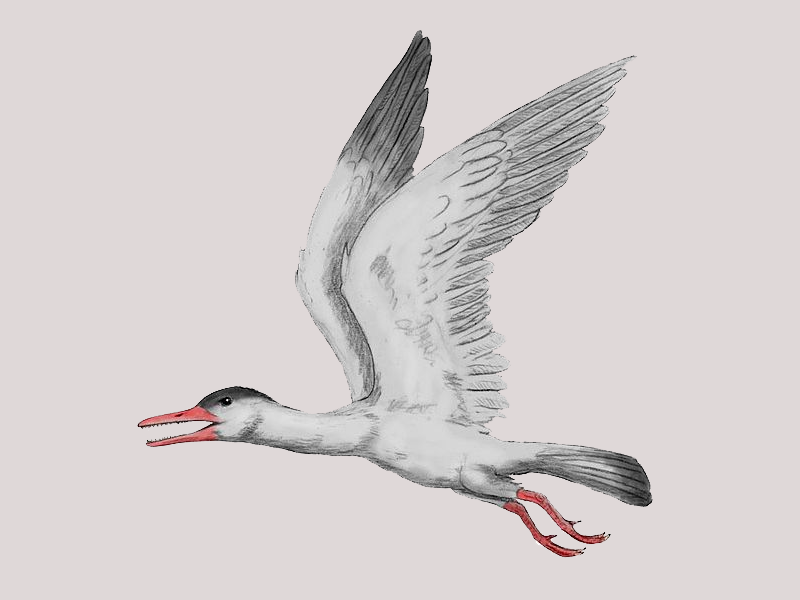In 1870, parts of a fossilized bird were found in Kansas and then described by the American paleontologist Othniel Marsh. This new bird, dubbed Ichthyornis dispar, was one of the first fossil birds found in North America, and there was something special about it. It was recognized as a scientifically important specimen due to the teeth found along its bottom jaw – something modern birds lack but were present in their dinosaur ancestors. However, the parts of the skull found in the 1870 specimen were extremely fragmented and not much could be reconstructed from the early specimens. The true significance of Ichthyornis’ skull would not become apparent until the discovery of a more complete skull – something that would not happen for over another 130 years. Recently, a student in Kansas discovered one of the most complete skull of Ichthyornis ever found. This finding would help scientists more clearly understand bird evolution.
Recently a group of scientists performed CT scans (yes, like the ones you get in the hospital) of five Ichthyornis skulls and used these scans to make a single, complete 3D skull. New evidence from a well-preserved Kansas specimen allowed unprecedented views of the jaws and braincase of Ichthyornis. Bird skulls from the Late Cretaceous (~86 million years ago) are typically incomplete, crushed, or altogether missing thus making reconstruction difficult if not impossible. The composite skull created in this study showed that the bones that make the jaws of Ichthyornis had things in common with both older extinct birds as well as modern birds.
In Ichthyornis, the tip of the upper jaw (called the premaxilla) was small and was the only part that did not have teeth. In modern birds, this part is much larger, and still does not have teeth. It is also much larger in Archaeopteryx, another famous fossil bird that lived 150 million years ago in what is now Germany. However, the premaxilla of Archaeopteryx still had teeth!
Another feature was missing from Archaeopteryx and in Ichthyornis. Modern birds have their beaks covered in keratin, which the same material of human fingernails and hair. However, until the recent discovery of a well-preserved Ichthyornis skull, scientists were not sure of when the keratin beak of birds began. The presence of the small beak with no keratin in Ichthyornis shows that the beak was developed during the time of the dinosaurs and that it developed alongside the teeth that were already present in the mouth of early birds.
Another important aspect of the composite skull discussed in the paper is that the bones surrounding the brain showed the general shape of the brain. According to the paper, the brain was nearly identical to the general shape found in modern birds with a glaring exception found along the braincase – the attachment points for the jaw muscles were larger than expected. This means that the mouth muscles for Ichthyornis would have been stronger than those in modern birds. This means that the muscles in Ichthyornis were more like that in dinosaurs than those in modern birds.

This fossil demonstrates two important points in bird evolution. First of all, the jaws and teeth of Ichthyornis are transitional between earlier birds/predatory dinosaurs and modern birds. Since modern birds do not have teeth and have a keratin covered beak and many ancient birds have been found with numerous teeth and no beak, a transitional form of bird had to exist somewhere in the fossil record. Ichthyornis had a full row of teeth along its jaw and had a small toothless beak at the tip of its jaws. Secondly, the brain proportions of Ichthyornis closely resembles that of modern birds but the jaw muscles were still more dinosaurian than birdlike. This combination of modern and prehistoric makes Ichthyornis a great example of a transitional form and highlights where some of the key points of bird anatomy got their start.
Overall, Ichthyornis represents an immensely interesting point in bird evolution where the iconic bird beak was first starting to appear, the remnants of dinosaur muscle attachment were still present, and a bird-like brain suggesting ability to fly. It can be said that all fossils are intermediate forms of later organisms but transitional fossils of birds are incredibly rare. Ichthyornis is an incredible point of reference for bird evolution and will continue to reveal new evolutionary concepts as more of the bird is analyzed.


